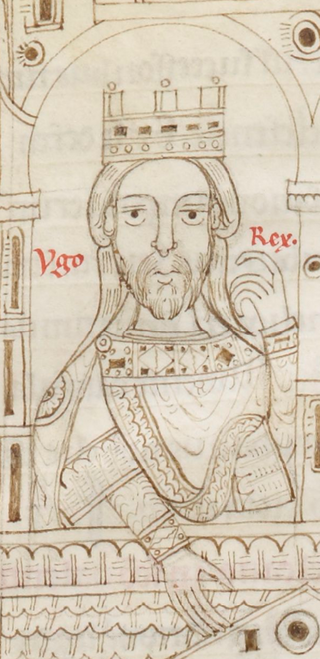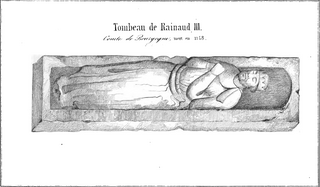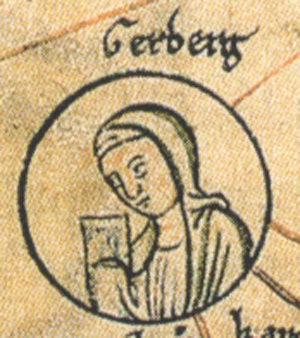
Gisela of Burgundy, a member of the royal Elder House of Welf, was Duchess of Bavaria from about 972 to 976 and again from 985 to 995, by her marriage with Duke Henry the Wrangler. She was the mother of Emperor Henry II.

Henry II, called the Wrangler or the Quarrelsome, a member of the German royal Ottonian dynasty, was Duke of Bavaria from 955 to 976 and again from 985 to 995, as well as Duke of Carinthia from 989 to 995.
Louis the Blind was the king of Provence from 11 January 887, King of Italy from 12 October 900, and briefly Holy Roman Emperor, as Louis III, between 901 and 905. His father was a Bosonid and his mother was a Carolingian. He was blinded after a failed invasion of Italy in 905.
Otto-William was count of Mâcon, Nevers, and Burgundy.

Hugh, known as Hugh of Arles or Hugh of Provence, was the king of Italy from 926 until his death. He belonged to the Bosonid family. During his reign, he empowered his relatives at the expense of the aristocracy and tried to establish a relationship with the Byzantine Empire. He had success in defending the realm from external enemies, but his domestic habits and policies created many internal foes and he was removed from power before his death.
Rudolph II, a member of the Elder House of Welf, was King of Burgundy from 912 until his death. He initially succeeded in Upper Burgundy and also ruled as King of Italy from 922 to 926. In 933 Rudolph acquired the Kingdom of Lower Burgundy (Provence) from King Hugh of Italy in exchange for the waiver of his claims to the Italian crown, thereby establishing the united Kingdom of Burgundy.
Rudolph III, called the Idle or the Pious, was the king of Burgundy from 993 until his death. He was the last ruler of an independent Kingdom of Burgundy, and the last male member of the Burgundian group of the Elder House of Welf.

The Kingdom of Lower Burgundy, also called Cisjurane Burgundy, was a historical kingdom in what is now southeastern France, so-called because it was lower down the Rhône Valley than Upper Burgundy. It included some of the territory of the Kingdom of Arelat.

Reginald III, son of Stephen I and Beatrice of Lorraine, was the count of Burgundy between 1127 and 1148. Previously, he had been the count of Mâcon since his father's death in 1102, with his brother, William of Vienne. His mother, Beatrice of Lorraine, was the daughter of Gerard, Duke of Lorraine. Pope Callixtus II was Reginald's paternal uncle.

Lothair II, often Lothair of Arles, was the King of Italy from 947 to his death. He was of the noble Frankish lineage of the Bosonids, descended from Boso the Elder. His father and predecessor was Hugh of Provence, great-grandson of Lothair II, King of Lotharingia, and his mother was a German princess named Alda.

Conrad I, called the Peaceful, a member of the Elder House of Welf, was King of Burgundy from 937 until his death.

The Kingdom of Burgundy, known from the 12th century as the Kingdom of Arles, also referred to in various context as Arelat, the Kingdom of Arles and Vienne, or Kingdom of Burgundy-Provence, was a realm established in 933 by the merger of the kingdoms of Upper and Lower Burgundy under King Rudolf II. It was incorporated into the Holy Roman Empire in 1033 and from then on was one of the empire's three constituent realms, together with the Kingdom of Germany and the Kingdom of Italy. By the mid-13th century at the latest, however, it had lost its concrete political relevance.

Charles of Provence or Charles II was the Carolingian King of Provence from 855 until his early death in 863.

Gerberga of Saxony was a Queen of France by marriage to Louis IV of France between 939 and 954. She ruled as regent of France during the minority of her son Lothair in 954–959.
Ermengard of Italy was Queen of Provence as the spouse of King Boso. She was the second and only surviving child of Emperor Louis II. In her early life, she was betrothed to Constantine, the junior Byzantine emperor, but whether the marriage actually occurred or not is still debated among historians. In 871, Ermengard and her family were taken hostage by Adelchis of Benevento but were later freed. In 876, Ermengard married Boso, a nobleman with connections to the Carolingian dynasty, and became queen upon his accession to the throne of Provence in 879. After her husband's death in 887, she served as regent of the kingdom during the minority of her son Louis the Blind.
Adelaide-Blanche of Anjou(c. 940 –1026) was, by her successive marriages, countess of Gévaudan and Forez, of Toulouse, of Provence, and of Burgundy, and queen of Aquitaine. She was the regent of Gevaudan during the minority of her sons in the 960s, and the regent of Provence during the minority of her son from 994 until 999.
The Bosonids were a dynasty of Carolingian era dukes, counts, bishops and knights descended from Boso the Elder. Eventually they married into the Carolingian dynasty and produced kings and an emperor of the Frankish Empire.
The count of Vienne was the ruler of the Viennois, with his seat at Vienne, during the period of the Carolingian Empire and after until 1030, when the county of Vienne was granted to the Archdiocese of Vienne.

Matilda of France, a member of the Carolingian dynasty, was Queen of Burgundy from about 964 until her death, by her marriage with King Conrad I.
Willa of Burgundy was a member of the Elder House of Welf. By birth she was a daughter of Rudolph I of Burgundy, king of Upper Burgundy. Through marriage Boso Willa became countess of Avignon and Arles, and then margravine of Tuscany.